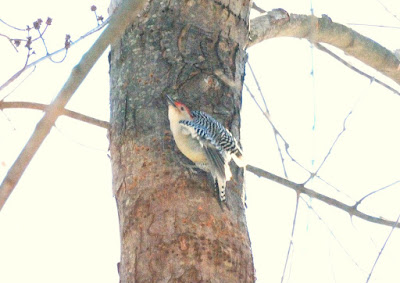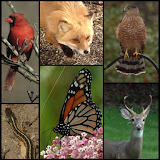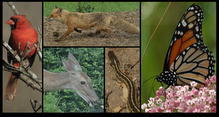Tuesday, December 22, 2009
Wednesday, May 20, 2009
Injured Snapping Turtle

If you clook closely you will see that he only has one eye. And, I know that snappers do not have teeth, but it surely looks like small teeth in these photos.
Unfortunately, the reason for his walking in circles became clear - this snapper had been run over by a car - the rear right shell was damaged and bloody - the rear right leg clearly damaged. I finally managed to move him (using the stick) to the side of the road. I doubt that he made it. You can find a great snapping turtle at http://www.tortoisetrust.org/articles/snappers.htm.
Posted by
Gil Miller
at
8:30 PM
1 comments
![]()
Labels: Turtle
Sunday, May 03, 2009
Red-Tailed Fox Eating Sunflower Seeds
This spring we have had a fox hinting in the Colvin Run Habitat. We have seen this fox chasing squirrels - one time successfully. We even have squirrel parts to prove his presence. But, no photos - until today. This young fox came on two occasions - separated by about an hour - and feasted on sunflower seeds on the ground under the bird feeder.
This young fox came on two occasions - separated by about an hour - and feasted on sunflower seeds on the ground under the bird feeder. Although his coat is clearly dirty and wet (it has been raining in Northern Virginia for at least three days, this fox appears in good health. He has no signs of mange and he has clear eyes. As the photos show, he and I spend several minutes eye-to-eye (or eye-to-lens). I stayed on the porch hoping not to spook him.
Although his coat is clearly dirty and wet (it has been raining in Northern Virginia for at least three days, this fox appears in good health. He has no signs of mange and he has clear eyes. As the photos show, he and I spend several minutes eye-to-eye (or eye-to-lens). I stayed on the porch hoping not to spook him.
Posted by
Gil Miller
at
4:57 PM
0
comments
![]()
Labels: Red-tailed Fox
Saturday, April 18, 2009
Tight Fit for Blluebird
A few minutes ago I took a break from the office work and walked the Colvin Run Habitat. Having noticed yesterday that in the last ten days the bluebirds had built a nest and laid several eggs, I was interested in shooting a few photos of them.
Posted by
Gil Miller
at
7:50 PM
0
comments
![]()
Labels: Bird Houses, Eastern Bluebird, Nests
Tuesday, April 07, 2009
Chickadees Move In
I put this bird house up with the expectation of having one house wrens or Carolina wrens take up residence. Both wrens and the bluebirds have been seen going into and out of this house, for now the chickadees seem to have taken up residence. We'll see if they actually build a nest.
Posted by
Gil Miller
at
12:01 AM
0
comments
![]()
Labels: Bird Houses, Chickadees
Monday, April 06, 2009
Blubirds Inspect the Bird House
Posted by
Gil Miller
at
12:01 AM
0
comments
![]()
Labels: Bird Houses, Eastern Bluebird, Nests
Sunday, April 05, 2009
Eastern Bluebirds Arrive
The first two photos show the female resting in the yet to bloom dogwood tree. The second two photos show the male in the oak tree and sitting on the roof of one of the bird houses.
As you can tell the female is slightly duller in color than the male. These photos show off the brilliant orange breast blue backs of the bluebirds.
Posted by
Gil Miller
at
4:53 PM
0
comments
![]()
Labels: Bird Houses, Eastern Bluebird
Space Available
Posted by
Gil Miller
at
12:01 AM
0
comments
![]()
Labels: Bird Houses
Wednesday, March 25, 2009
Earth Hour 2009
I hope that all of you will participate in this Saturday's Earth Hour 2009 event. Event organizer, World Wildlife Fund, is asking individuals, businesses, governments and organizations around the world to turn off their lights for one hour – Earth Hour – to make a global statement of concern about climate change and to demonstrate commitment to finding solutions.
So, turn your lights out for an hour this Saturday at 8:30 PM local time and join a worldwide community to make a statement bout climate change.
Posted by
Gil Miller
at
6:41 PM
0
comments
![]()
Thursday, February 05, 2009
Red-Bellied Woodpecker Enjoying the Maple Sap
 I believe that the sap is beginning to run on the maple trees. A good indicator is that the red-bellied woodpecker was observed pecking the maple tree bark. With a little luck in the next view weeks, we'll observe the yellow-bellied sapsucker, which has only been observed during February in the Colvin Run Habitat.
I believe that the sap is beginning to run on the maple trees. A good indicator is that the red-bellied woodpecker was observed pecking the maple tree bark. With a little luck in the next view weeks, we'll observe the yellow-bellied sapsucker, which has only been observed during February in the Colvin Run Habitat. This second photo shows the red-bellied woodpecker beginning his flight from a position of clutching the bark.
This second photo shows the red-bellied woodpecker beginning his flight from a position of clutching the bark.
Posted by
Gil Miller
at
9:52 PM
0
comments
![]()
Labels: Flight, Red-Bellied Woodpecker
Wednesday, February 04, 2009
Tufted Titmice
 Along with the Carolina chickadees, the tufted titmice come to the feeders in the Colvin Run Habitat every day. They help to consume the one and a half gallons of sunflower seeds consumed by all of the birds each and every day.
Along with the Carolina chickadees, the tufted titmice come to the feeders in the Colvin Run Habitat every day. They help to consume the one and a half gallons of sunflower seeds consumed by all of the birds each and every day.
Posted by
Gil Miller
at
9:51 PM
1 comments
![]()
Labels: Titmice
Tuesday, February 03, 2009
Red-Shouldered Hawk in Flight
Some more red-shouldered hawks for the Owlman. In three of the last four days, a red-shouldered hawk has been observed in the Colvin Run Habitat. Today, this hawk was perched in a tree and observed at sundown. With his dark brown back facing me, the tree being about 50 yards away, and his static position at sundown, he was very difficult to see. Our house, located on a hill, overlooks a meadow that is about 40 feet below. As I approached the hawk, he took off for the meadow. The result was a rare opportunity to photograph the hawk from above while he was in flight. In this photo, you can see the white barring and striping on the top of the tail and wings. Even in the dim light of dusk, this is a large and beautiful predator.
Our house, located on a hill, overlooks a meadow that is about 40 feet below. As I approached the hawk, he took off for the meadow. The result was a rare opportunity to photograph the hawk from above while he was in flight. In this photo, you can see the white barring and striping on the top of the tail and wings. Even in the dim light of dusk, this is a large and beautiful predator.
Posted by
Gil Miller
at
9:00 PM
0
comments
![]()
Labels: Flight, hawk, Red-Shouldered Hawk
Sunday, February 01, 2009
Day of the Hawks: Cooper's Hawk
In addition to the pair of red-shouldered hawks today, this Cooper's Hawk also was observed. I got a photo of the Cooper in one of the azalea bushes, but also observed him on the ground under the bird feeder as he attempted to grab one of the smaller birds to eat. As the Cooper's and red-shouldered hawks are about the same size and have some similar color traits (feddish chest, reddish under the wings), here is how I tell the two apart:
As the Cooper's and red-shouldered hawks are about the same size and have some similar color traits (feddish chest, reddish under the wings), here is how I tell the two apart:
>Cooper's back is dark gray while the red-shoulder's back is dark brown with some white specks.
>Both have barred tails - Cooper's is black bar, red-shoulder's is white
>The red-shoulder's neck is much thicker than the Cooper's. When observing them with a bright or blue-sky background this can be very helpful.
Posted by
Gil Miller
at
9:02 PM
0
comments
![]()
Labels: Cooper's hawk, hawk
Saturday, January 31, 2009
Day of the Hawks: Red-Shouldered Hawk Pair
 A pair of red-shouldered hawks arrived was observed early this morning. As red-shouldered hawks are known to return to a given locale for many years, I would like to think that today's pair is the pair observed on three occasions in 2007 (1, 2, 3).
A pair of red-shouldered hawks arrived was observed early this morning. As red-shouldered hawks are known to return to a given locale for many years, I would like to think that today's pair is the pair observed on three occasions in 2007 (1, 2, 3). Later in the afternoon, a single hawk was observed on two occasions - or was it on observation of each of the two hawks.
Later in the afternoon, a single hawk was observed on two occasions - or was it on observation of each of the two hawks. I managed to catch one of the red-shoulders in flight also.
I managed to catch one of the red-shoulders in flight also.
Posted by
Gil Miller
at
9:06 PM
1 comments
![]()
Labels: Flight, hawk, Red-Shouldered Hawk
Friday, January 30, 2009
White-tailed Deer Herd
 They now come as a herd of at least eight. Yes, these photos show only six, but out of camera width are another two. If you get too close, one of the mothers will raise her head and stare you down. With so little vegetation left and this week's snow on the ground, they eat any seed on the ground. They also will bump the feeder to put more seed on the ground. I have to work hard to get them to leave - which I must do as they consumer large amounts of seed and water that I put out for the birds.
They now come as a herd of at least eight. Yes, these photos show only six, but out of camera width are another two. If you get too close, one of the mothers will raise her head and stare you down. With so little vegetation left and this week's snow on the ground, they eat any seed on the ground. They also will bump the feeder to put more seed on the ground. I have to work hard to get them to leave - which I must do as they consumer large amounts of seed and water that I put out for the birds. Of the eight, three are the mother who delivered twins last spring (we lost the male father in late fall) and two are the mother and her single fawn from last spring. No idea where the herd picked up the last three in the herd of eight. Now, last spring's fawns are the same size as mom.
Of the eight, three are the mother who delivered twins last spring (we lost the male father in late fall) and two are the mother and her single fawn from last spring. No idea where the herd picked up the last three in the herd of eight. Now, last spring's fawns are the same size as mom.
Posted by
Gil Miller
at
9:23 PM
0
comments
![]()
Labels: White-tailed Deer
Wednesday, January 14, 2009
Update and Summary: Foxes with Mange

First and foremost, regardless of how cute they are, foxes are wild animals. Kids - talk to your parents. Parents - make sure you use good judgment and appropriate caution.
Fact and Fiction about Foxes with Mange:
>It is very common for individuals to believe that if they see a fox near their homes, looking or acting sick, that it must have rabies. 99% of the time this is not the case.
>The animal most likely is suffering from mange; a debilitating condition that causes severe scratching, open sores and loss of hair. >The good news is that it is easily treatable.
Information to help you understand an animal with mange:
>A fox with mange is very weak from an inability to hunt for food.
>They are tired and suffering from constant itching and burning sensations.
>Because they must eat they will venture close to homes looking for food. Pet food that is left outside is a frequent choice.
>The fox will not attack cats, dogs or children. Even under normal circumstances it is not aggressive. It will react however, if trying to be captured.
>They do not want to take up residence in your area permanently. If treated and allowed to recover they will move on.
However, mange, like many illness, needs to be treated with medication:
>See this site from upstate New York for details
>Mange in foxes is treatable with Ivermectin which is inexpensive and easy to obtain.
I am hoping that the recent anonymous commenter from Great Falls, Viriginia (a community adjacent to the Colvin Run Habitat), will continue to keep us up to date on the progress of treating his foxes.
If you have observations of foxes with mange and especially if you are able to treat mangy foxes with Ivermectin, I hope that you will post a comment and let us know your actual experiences and results.
In the meantime, 9 months have passed since we have observed a fox in the Habitat. But hope springs eternal, and we continue to wait for another blessing of foxes.
Posted by
Gil Miller
at
8:28 PM
0
comments
![]()
Labels: Mange, Red-tailed Fox
Friday, January 02, 2009
Unidentified Slug
I do not know what kind of slug it is...a banana slug??? Since someone identified the spider, I am hoping someone will identify this slug. Anyone???
This slug was moving around the nylon grill cover. In the first two photos, you can clearly see the slim trail left.
These photos were taken last summer.
Posted by
Gil Miller
at
4:50 PM
0
comments
![]()
Labels: 2008 Summer, Slug




























